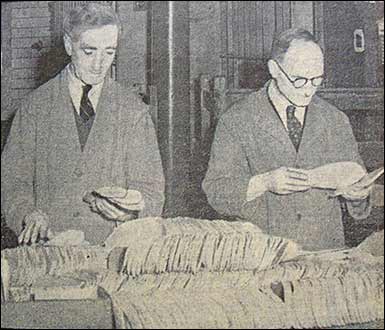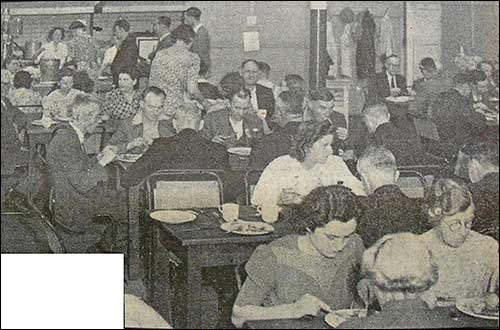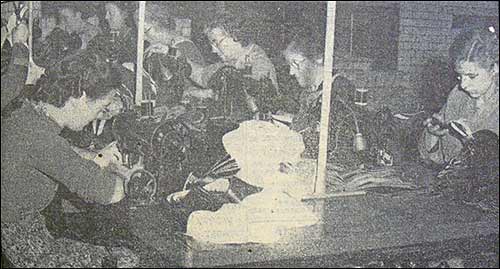One of the largest and most solid monuments to the boot industry in Rushden is the C.W.S. factory, which stretches far along Portland Road. Though by no means the oldest in Rushden, the enterprise it houses is nearing a very notable half-century, and celebrations of the jubilee are already been laid on for November 23rd and 24th.
The boot-making tradition was so well established in Rushden by 1899 that the Co-operative Wholesale Society, needing a manufactory that would supply footwear to Co-operative shops throughout the country, took no half-measures. In purchasing a factory that stood at the corner of Portland Road and Rectory Road, they also acquired a good deal of surrounding property.
No sooner had production began under the management of Mr. Frank Ballard, from Kettering, than builders were at work adding a long new section which changed the whole appearance of the street.
Top-hatted directors converged on Rushden to open this large extension in 1901 and satisfied themselves that they had provided the most modern type of factory with up-to-date machinery and what were then accepted as ideal working conditions. The girl employees wore their sailor hats and big-buttoned jackets and felt proud to be associated with such a building.
Fire Disaster
That was an eventful year for the local industry, because Cave’s factory in High Street— the largest works for miles around — was wiped out by fire. The C.W.S. then took first place in the town and helped to stabilise the position arising from the disaster.
Heavy boots for men and boys were made in the new factory — and outside it also, for out-work was common in those days, and uppers and bottoming materials were issued in large quantities for the out-workers to make up in their own homes.
The original factory at the corner was subsequently demolished and in its place arose the impressive Rectory Road office block, with large showrooms and stockrooms.
Mr. Ballard, a man of much influence in local affairs, retired in 1912, and Mr. Leonard Tysoe, who had been with Charles Parker’s at Higham Ferrers, succeeded him.
By this time lighter footwear was becoming popular, and box, willow and glace leathers were replacing the stouter grades; but with the outbreak of the First World War the factory had to concentrate for a few years on boots for Russia’s Cossacks and infantry units and for the armies of Britain, Italy, Serbia and Rumania.
Extended
Mr. Tysoe’s managerial work extended for some years to the C.W.S. factories at Norwich – where ladies’ shoes were produced – Kempston and Northampton. Retiring on the age limit in 1932, Mr. Tysoe was followed by Mr. F. Clifton, of Leicester, who served until January, 1946.
Reginald Smith, the next in line, is now group manager of all the C.W.S. factories producing men’s and boys’ footwear – at Rushden, Northampton, Leeds, Heckmondwyke and Kempston (an upper closing unit).
 |
 |
|
Two long serving members of the staff at CWS.
|
Jubilee dinners may not be on the programme at the factory’s bright and well run canteen, but the caterers are already planning entertainment for the whole of the employees at the Windmill Hall on November 23rd and 24th.
|
The resident manager at Rushden is Mr. C. H. Jeeves, who entered the works as a junior in the office 42 years ago.
In 1939 the factory’s output approached one million pairs, and during the Second World War well over half a million pairs of Army boots were made. The standard of product is constantly improving and is second only to that of the Northampton factory, which handles the No. 1 grades.
As far as supplies of raw materials and other conditions will allow, production is again increasing, and to meet this situation it is planned to extend the factory substantially as soon as possible.
Size 18½
More than 2,000 pairs of surgical and bespoke boots and shoes are made each year, and the factory has one very interesting customer – a young man over seven feet tall who requires 18½-size shoes. Even as a youth this giant needed 17’s, and from his school days special lasts have been kept to meet his requirements.
In all departments of the factory the original sense of spaciousness is still apparent, and the showroom must be one of the finest in the trade. The buyers who walk the polished floor are all Co-operative agents, but as their buying is not necessarily confined to C.W.S. sources the factory has to cater on full competitive lines.
As would be expected, the employees have a habit of staying put, and the current service dockets go back to 1903 when Mr. W. O. Rowthorn, of the Preparation Department, started work at the age of 13.
For many years it was a rule that married women should not be employed, but that stipulation is very much obsolete and to-day the great majority of the closers are married.
 |
|
Everyday scene in the closing room, where the girls work under pleasant conditions. We said “girsl” but the majority of them are married.
The old ban on married women hads had to be lifted.
|
The factory’s roll of pensioners – who run their own Social Club – is large and includes two former chief citizens of Rushden – Mr. J. T. Richardson and Mr. E. A. Sugars. Mr. C. H. Neal, the retired head clerk, claims 47 years’ service.
In addition to the excellent pension scheme the factory offers an up-to-date canteen and has an active Sports and Social Committee which organises socials, dances, theatre and seaside outings and an annual flower show. It also has its own Fire Brigade, captained by Mr. Jack Wildman, whose father was the first captain.
|